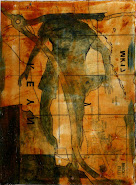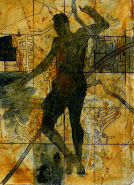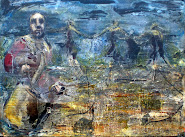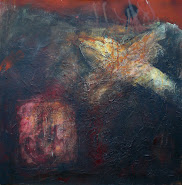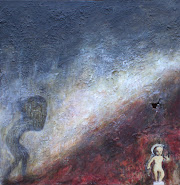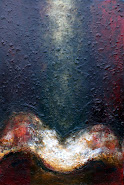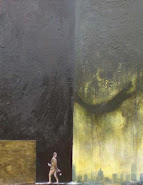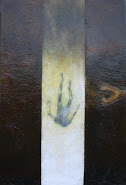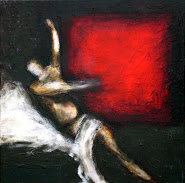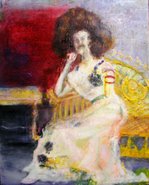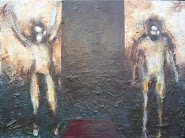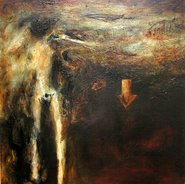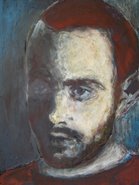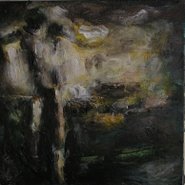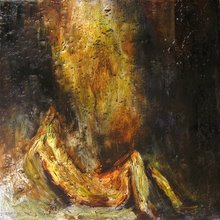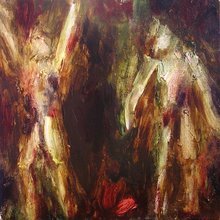I dont wish to sound the alarm bells with Daily Mail like headlines, but I can't help thinking there is some form of condition that drives certain people to paint. Despite many more sensible, logical, fruitful or obvious avenues a large number of people over the years have taken to using sticky fluids filled with pigments to create patterns and images across stretched white fabrics. These few people perform an act which seems so profound to them but so vacuous adn poitnelss to so many other. Despite protestations to the contary painting is still an elitist pursuit. Ask you average punter there views on music and the chances are your ear will be cehwed off untill a bloddy hole is left at the side of your head. Ask the same ian two pence worth and he will look at you with profound disinterest. I might sound cyncial but I have a few bright, interested and non tunnel visioned friends for whom painting is as meaningful as ........ (im too tired to think or enter something amusingly uninteresting)
it strikes me, therefore, and I pose the question not the answer, that painting must actually be a condition of sorts. That there is some kind of neurosis which drives us to squeeze out this bits of colour and dispense them over two dimesnions with orgasmic and self indulgant delight and despair. (largely the later, which makes our desire to continue even moire bizarre) I have been thinking refcently how I really wish I did not paint, how I would much prefer a simple option, a more systemmatic and linear progression to measure development. But it does not seem to stop me following pretentious dead ends which revolve around pastes and hues.
It has led me to believe I need to read Elkins 'What Painting is' again. It is a bizarre and interesting book which I only read in broken fragments first time around. He compares painting to alchemy. It is part of a common contemporary strain of literature which uses such comparisons as a methodological tool to get to tackle the issue of there central concern. It is the use of one discipline as a knife the messy and bloody ontological disputes of another. In this case it works. He gets, from memroy, to the point that there is something about the medium itself and the process of its application (beyond any more specific, mimetic or philosophical reason) that has made painting a continuous but peripheral obsession of humanity.
once I have re-read this book i will try and take a step back and reevaluate some of the points I have raised above.
In hindsight, the above few paragraphs could have been written in three sentences. Oh well.
Our Artwork
Tuesday, 25 September 2007
Technical problems (more of a diary entry than anything else)
Working on a painting called 'Mary The Queen and The Sower Of Seeds'. First of all I am wondering whether this title is appropriate. I have concerns over the nature of narrative within painting, specifically how we choose to use this device and how it can best be exploited in the framework of a painting, and as such, is this title suggesting too explicitly the role of narrative within the work, causing viewers to ignore other subtler aspects? I am thinking particularly about the inclusion of evidence for psychoanalytic learning, trusting not necessarily in a chronological story-telling, but more in accurate characterisation and symbolic reference to suggest, not specific narrative, but an emotional space which hints at a story yet allows space for the viewers personal interaction. Although I do like the Folky Englishness of the title and this is a quality I am trying to find and refine in my work. This includes being more specific with colours and finding a certain personal awkwardness which is so often apparent in the best of 20th century british art (I'm thinking here about Michael Andrews, early Lucien Freud, David Bomberg and Francis Bacon).
In 'Mary.....' a wicker chair is proving a problem. It needs to reflect a colouristic relationship with the shadow above the window and the harpists shoes, this means that its colour needs to be changed from brown to red and the way that each colour reacts to reflection and shine is different. How then, do I show its material characteristics? What colours do I use and where? Using Neo Rauch's 'Reflex' as an aid, in this painting there are two divers wearing red wetsuits which have a similar cheap plastic quality to the chair. The application is essentially simple with the tonal separation the key. clearly defined dark cool red and and high pitched cool red. There is then flecks of warm red often coupled with the high pitched cool. In some areas there appears a blue/purple which exists in the region of a mid-tone yet is used sparingly to suggest reflection.
the majority of this should be painted wet in wet to allow a slight mixing between the colours to create the effect of light.
In 'Mary.....' a wicker chair is proving a problem. It needs to reflect a colouristic relationship with the shadow above the window and the harpists shoes, this means that its colour needs to be changed from brown to red and the way that each colour reacts to reflection and shine is different. How then, do I show its material characteristics? What colours do I use and where? Using Neo Rauch's 'Reflex' as an aid, in this painting there are two divers wearing red wetsuits which have a similar cheap plastic quality to the chair. The application is essentially simple with the tonal separation the key. clearly defined dark cool red and and high pitched cool red. There is then flecks of warm red often coupled with the high pitched cool. In some areas there appears a blue/purple which exists in the region of a mid-tone yet is used sparingly to suggest reflection.
the majority of this should be painted wet in wet to allow a slight mixing between the colours to create the effect of light.
Friday, 21 September 2007
Geist- from cupid to the crow (a sketch)
He would dress up as Cupid bu strip as the Crow
The geist picked up the phone.
His ethereal voice demanded corporeal incarnation.
Royal mail sent the package.
Unseen he clibed into the costume.
Soft white wings and the lie of youth.
Born as cupid, dirty little protagonist.
A paper ladder reached to the sun.
His arrows gave birth to infinate embraces
Each with a promise of eternal love
Sworn on the bible of Shakespeare
In memory of the jester and Lear
Death and Solitude sat waiting,
In a vacuous armchair
Skipping through time and space
Dragging our cupid upwards at pace
The train pulled up at the station
The light and heat waited in the cafe.
A filthy coffee and two crumbling digestives
The sun lay bare her thighs
Cupid licked the centre, burning and glutonous
Greedy, lustful little bastard
The seductive cruel bitchdevoured him whole
In ritual dance the autumn leaves sung odes to spring
"yummy" she scread and moaned
"Oh crap" he cried and groaned
She spat out his greasy love bones
Soft white wings turned charcoal tough,
Arrows as phallus, penetrated through his skull.
A beak was born.
He fluttered around the theatre
A conductor exiting stage right
Behind him drama was born
To drown in a sea forlorn
The geist picked up the phone.
His ethereal voice demanded corporeal incarnation.
Royal mail sent the package.
Unseen he clibed into the costume.
Soft white wings and the lie of youth.
Born as cupid, dirty little protagonist.
A paper ladder reached to the sun.
His arrows gave birth to infinate embraces
Each with a promise of eternal love
Sworn on the bible of Shakespeare
In memory of the jester and Lear
Death and Solitude sat waiting,
In a vacuous armchair
Skipping through time and space
Dragging our cupid upwards at pace
The train pulled up at the station
The light and heat waited in the cafe.
A filthy coffee and two crumbling digestives
The sun lay bare her thighs
Cupid licked the centre, burning and glutonous
Greedy, lustful little bastard
The seductive cruel bitchdevoured him whole
In ritual dance the autumn leaves sung odes to spring
"yummy" she scread and moaned
"Oh crap" he cried and groaned
She spat out his greasy love bones
Soft white wings turned charcoal tough,
Arrows as phallus, penetrated through his skull.
A beak was born.
He fluttered around the theatre
A conductor exiting stage right
Behind him drama was born
To drown in a sea forlorn
Some notes
I recently starting workiong as a lecturer and tutour on an art foundation course. I also split from a long term girlfriend. These two events, one positive the other negative, have perpetuated a recent paralysis in regards to writting on this site. I have also noticed a parallel slowing down of ideas for future paintings. Consequentially the process has been helpful. it has confirmed my intial hope that this blog woudl provide an improtant cog in the creative process. Its abscence has conifrmed this to be true.
A fair few things have taken my interest in the last few weeks but I have not had the time or inclination to articualtew them here. Firstly I still need to write up some notes on my visits to the Callum Innes and Howard Hodgkin shows. Once my scanner is set up i shall do this. I would also like to upload my lecture notes and images. The danger is that these are rather long and also touch on some points made in previous blogs. I do think it would be beneficial and interesting though. Andy, let me know if you think it is not appropriate. From my view point the more stuff we can get up of relevance the better. A long sprawling blog post is not too much of a problem as it soon get reduced to a title as we move from one month to the next. Anyhow... I dgress as per usual.
Was extremely touched by Andy's poem and it made me realise that my poetry, which I have so enjoyed writting again (despite its inadequacies) has dired up. So firstly I wrote a reply to Andy's poem and I will upload my next poem after this post. The next poem is a rift on the prescence of the flying, crow like figure (protagonist) in my paintings. I wanted to use poetry as a organic process in which to investigage the ideas which I have attached to this symboil. Notions of tragic inevitability, the exit of a protagonist from the painting as a stage etc etc. Poetry seems a far more appropriate medium for this exploration than more analystical writting. Analytical writting forces us to justify, to describe, to define. Poetry can get closer to the true meaning of painterly elements as it deals in similar elusive and less tangible descriptions.
I recently finished my two paintings 'The Wake of Endymion' and 'Lucretia' and will soon have finished 'Icarius II'. I thought I shoudl jot some notes down on these before I forget. I shall upload the pictures when I get a chance.
Lucretia- I covered these previously. 'Icarus'- Andy hit the naiul on the ehad with this subject. I think I am pulled optwards it as it touches upon the timeless nature of mans pursuit for perfection and its inevitable decline. The fall of Icarus is what interests me. The latest version attempts to conjure up a more contemporay depiction. Icarus not being a visual prop I need to latch onto, but a metaphor for what the painting is about. Not that the work moves away from the obvious figurative element of a falling man. It is just more that the context gives a nod towards our present culture. My only worry is that the nod could seem explitally to reference the evenets and attached poliitcal debates of the Twin Towers attack. That is not what I wanted. The architectural reference more came from a desire to use the geometry of the surface, a division into clear rectilinear sections, as Poussin or David might. (obviously in a far less sophisitcated manner) I wanted to use these divisioons to reinforce the sense of the fall, the sesne of its inevitability, the sense of the vertical energy vs the horizontal energy of the 'crow'.
'The Wake of Endymion' The figure quotes Girodet's Endymion. The subject of Endymion interests me. It is a highly romantic story. The notiuon of a young and beautiful mortal being sent to sleep for eternity. It deals with the romantic painters desire for painting, beauty and youth to be eternal. It is the kind of notion I aspired to for ages. Then suddenly you realise that transcience is inexcapable. Time and change (crucial parts of the Crows fabric) ensure we cannot hold onto the moment. In fact the beuty of the moment is the fact it does not last. It only exists in a positive light due to its fleeting nature, due to its relation to what comes before and after. If it exists permanently in a vacuum to this then it loses its appeal. It becomes vacuous and empty.
So I thought I would paint 'The Wake of Endymion' a paradoxical notion when you consider the story. That moment of awakening that never happened. The notion that the Crow arrived, moved thorugh time and space and interupted the dreamy eternal state that they aspired too. A pretentious side of me would call this tragic realism.
When I upload the painting you will see if I have acheived any of the above. I have taken the original figure an shown him reaching up to the light, as if his consciousness and awarenss of the lgihts prescence has awakened. His form breaks up, movign to abstraction, getting eaten by the shadows. The destruction of image relates, hopefully, to the sense of transcience.
I have also tried to create a surface which appears time worn but seems to sztart to break up in front of our eyes. From the edges to the centre I have attempted to create a sense of change in the surface itself. So the very medium and its application refers to the narrative context. If I have got anywhere near this I will be happy. For ultimately, as a painterly painter, I belivee the medium itself should be critical and central to the articualtion of meaning and poetry.
I have another painting, with the drummer boy and dancers, which has been a long time in planning without yet making its way towards a canvas. I am in danger of fear setting in. I just wanted to quickly touch on one tihng that painting wants to do though. I want to following from David in the sue of a stoic fiugre. Figures whose abscenbce of emotion is the sign of deep internal unrest. Also I am interested in manets use of masked, outward facing figures. They face us, suggesting a desire to communicate. yet everything about them evades any such communication. They offer us something then appear vacuous. The elusiveness is the key to meaning in Manet's work I believe. At times it is deeply troubling and melancholic.
One last not. i have started a third and fourth version of Danae. In both I am looking to pursue and puch further the idea of her body as a container which will receive both Jupiter (the light) and meaning. In these works she is pushed to the edge of figural representation. She is almost just a cup. If we read her as a female form it is only in the (hopefully) seductive fleshly quality of paint, or perhaps as a pair of detached open legs. If this works then I feel I am moving clsoer to the straddling of abstraction and representation which I desire. At this moment in time I have no idea if it does or not.
That is all for now. Apologies for the broken and waffley nature of this post. It has been a stream of consciousness. SO whatever its weakness or pretentious it is honest. That, above all else, is the most improtant thing.
A fair few things have taken my interest in the last few weeks but I have not had the time or inclination to articualtew them here. Firstly I still need to write up some notes on my visits to the Callum Innes and Howard Hodgkin shows. Once my scanner is set up i shall do this. I would also like to upload my lecture notes and images. The danger is that these are rather long and also touch on some points made in previous blogs. I do think it would be beneficial and interesting though. Andy, let me know if you think it is not appropriate. From my view point the more stuff we can get up of relevance the better. A long sprawling blog post is not too much of a problem as it soon get reduced to a title as we move from one month to the next. Anyhow... I dgress as per usual.
Was extremely touched by Andy's poem and it made me realise that my poetry, which I have so enjoyed writting again (despite its inadequacies) has dired up. So firstly I wrote a reply to Andy's poem and I will upload my next poem after this post. The next poem is a rift on the prescence of the flying, crow like figure (protagonist) in my paintings. I wanted to use poetry as a organic process in which to investigage the ideas which I have attached to this symboil. Notions of tragic inevitability, the exit of a protagonist from the painting as a stage etc etc. Poetry seems a far more appropriate medium for this exploration than more analystical writting. Analytical writting forces us to justify, to describe, to define. Poetry can get closer to the true meaning of painterly elements as it deals in similar elusive and less tangible descriptions.
I recently finished my two paintings 'The Wake of Endymion' and 'Lucretia' and will soon have finished 'Icarius II'. I thought I shoudl jot some notes down on these before I forget. I shall upload the pictures when I get a chance.
Lucretia- I covered these previously. 'Icarus'- Andy hit the naiul on the ehad with this subject. I think I am pulled optwards it as it touches upon the timeless nature of mans pursuit for perfection and its inevitable decline. The fall of Icarus is what interests me. The latest version attempts to conjure up a more contemporay depiction. Icarus not being a visual prop I need to latch onto, but a metaphor for what the painting is about. Not that the work moves away from the obvious figurative element of a falling man. It is just more that the context gives a nod towards our present culture. My only worry is that the nod could seem explitally to reference the evenets and attached poliitcal debates of the Twin Towers attack. That is not what I wanted. The architectural reference more came from a desire to use the geometry of the surface, a division into clear rectilinear sections, as Poussin or David might. (obviously in a far less sophisitcated manner) I wanted to use these divisioons to reinforce the sense of the fall, the sesne of its inevitability, the sense of the vertical energy vs the horizontal energy of the 'crow'.
'The Wake of Endymion' The figure quotes Girodet's Endymion. The subject of Endymion interests me. It is a highly romantic story. The notiuon of a young and beautiful mortal being sent to sleep for eternity. It deals with the romantic painters desire for painting, beauty and youth to be eternal. It is the kind of notion I aspired to for ages. Then suddenly you realise that transcience is inexcapable. Time and change (crucial parts of the Crows fabric) ensure we cannot hold onto the moment. In fact the beuty of the moment is the fact it does not last. It only exists in a positive light due to its fleeting nature, due to its relation to what comes before and after. If it exists permanently in a vacuum to this then it loses its appeal. It becomes vacuous and empty.
So I thought I would paint 'The Wake of Endymion' a paradoxical notion when you consider the story. That moment of awakening that never happened. The notion that the Crow arrived, moved thorugh time and space and interupted the dreamy eternal state that they aspired too. A pretentious side of me would call this tragic realism.
When I upload the painting you will see if I have acheived any of the above. I have taken the original figure an shown him reaching up to the light, as if his consciousness and awarenss of the lgihts prescence has awakened. His form breaks up, movign to abstraction, getting eaten by the shadows. The destruction of image relates, hopefully, to the sense of transcience.
I have also tried to create a surface which appears time worn but seems to sztart to break up in front of our eyes. From the edges to the centre I have attempted to create a sense of change in the surface itself. So the very medium and its application refers to the narrative context. If I have got anywhere near this I will be happy. For ultimately, as a painterly painter, I belivee the medium itself should be critical and central to the articualtion of meaning and poetry.
I have another painting, with the drummer boy and dancers, which has been a long time in planning without yet making its way towards a canvas. I am in danger of fear setting in. I just wanted to quickly touch on one tihng that painting wants to do though. I want to following from David in the sue of a stoic fiugre. Figures whose abscenbce of emotion is the sign of deep internal unrest. Also I am interested in manets use of masked, outward facing figures. They face us, suggesting a desire to communicate. yet everything about them evades any such communication. They offer us something then appear vacuous. The elusiveness is the key to meaning in Manet's work I believe. At times it is deeply troubling and melancholic.
One last not. i have started a third and fourth version of Danae. In both I am looking to pursue and puch further the idea of her body as a container which will receive both Jupiter (the light) and meaning. In these works she is pushed to the edge of figural representation. She is almost just a cup. If we read her as a female form it is only in the (hopefully) seductive fleshly quality of paint, or perhaps as a pair of detached open legs. If this works then I feel I am moving clsoer to the straddling of abstraction and representation which I desire. At this moment in time I have no idea if it does or not.
That is all for now. Apologies for the broken and waffley nature of this post. It has been a stream of consciousness. SO whatever its weakness or pretentious it is honest. That, above all else, is the most improtant thing.
Poem- a reply
Just an echo of a shadow...
Endymion sleeps, forever young and beautiful
Melting remote controls crawl up to the traffic lights
I suffocate you, fist down throat
The moons caresses skin with a soft and silent love call
Rainbow leaves dance there way from stage to floor
You push me away with concrete walls
Crow passes unseen to wake Endymion
A vacuous container of glossy magazines
Ended; love was not enough.
Endymion sleeps, forever young and beautiful
Melting remote controls crawl up to the traffic lights
I suffocate you, fist down throat
The moons caresses skin with a soft and silent love call
Rainbow leaves dance there way from stage to floor
You push me away with concrete walls
Crow passes unseen to wake Endymion
A vacuous container of glossy magazines
Ended; love was not enough.
Labels:
Andy Foulds,
endymion,
love,
Painting,
poem,
Tom de Freston
Wednesday, 19 September 2007
poem
Nothing else matters
Does it?
When the greatest of love die's.
When the red rose wilts upon the alter
And the rafters fill with sigh's.
The lightest of breezes may caress the tree's,
Yet the leaf will break and fall.
However much the branch would swoon,
Only crows to answer the call.
The pretty young woman who speaks of weather,
Say's nought much but rain.
The heavy boots of cow-hide leather
Stain the socks that itch the brain.
The jacket pinches below the arm,
Cuts in and then cuts out.
And the heart pinches below the calm,
cut in and then cut out.
What is it I could possibly say
That would help to ease the pain?
All I can say to each of you
Is, "was she ever the same?"
Does it?
When the greatest of love die's.
When the red rose wilts upon the alter
And the rafters fill with sigh's.
The lightest of breezes may caress the tree's,
Yet the leaf will break and fall.
However much the branch would swoon,
Only crows to answer the call.
The pretty young woman who speaks of weather,
Say's nought much but rain.
The heavy boots of cow-hide leather
Stain the socks that itch the brain.
The jacket pinches below the arm,
Cuts in and then cuts out.
And the heart pinches below the calm,
cut in and then cut out.
What is it I could possibly say
That would help to ease the pain?
All I can say to each of you
Is, "was she ever the same?"
Sunday, 16 September 2007
Short section of prose from Gunter Grass' From the Diary of a Snail
"When I was fifteen, I wanted, in thoughts, words and works, to murder my father with my Hitler Youth dagger. (From generation to generation the intention remains the same only the weapon changes.)
When I was sixteen I loved an unfinished girl- to be filled in as desired- from a distance; ever since, I have been able to wish and imagine until she knocks, comes in, and starts a fight.
When I was seventeen - held together only by my sword belt - I learned under my steel helmet to know fear, later (by way of compensation) hunger, and soon thereafter the vast wild animal corral known as freedom.
From eighteen on, I tried to survey that corral and discovered how intricately subdivided it is and how seldom reason and intellect are neighbours: the greater the intelligence, the more devastatingly its stupidity can run wild. It is seldom the fools, and often the shrewd and knowing, who try to make the worl pay for their defeats.
After that, I spent quite a long time living very little but only writing; I was a storehouse for dispersed fragments, also for duly entered losses."
I often find that so much of Grass' novels are as close to painting as prose can get. His writing exists in a world that doesn't follow traditional norms, at once floating from the auto-biographical to the fantastical, the chronology works not along some linear pathway, organised and rigid, but is tied to the unfiltered influence of memory, and as such you're never quite sure what is the facts of his life, what is made up characterisation and what simply floats away from any semblance of reality and off into surreal anecdote. Yet still, within this mesh of complex contexts and conceptual constructions you will find passages like the one previously shown here, that are exquisitly delicate, sensitive portrayals of humanity. It seems that however intricate the writing appears to be it still relies, like all great art, on those few epic themes of desire, loss, regret, politics and the spirit.
When I was sixteen I loved an unfinished girl- to be filled in as desired- from a distance; ever since, I have been able to wish and imagine until she knocks, comes in, and starts a fight.
When I was seventeen - held together only by my sword belt - I learned under my steel helmet to know fear, later (by way of compensation) hunger, and soon thereafter the vast wild animal corral known as freedom.
From eighteen on, I tried to survey that corral and discovered how intricately subdivided it is and how seldom reason and intellect are neighbours: the greater the intelligence, the more devastatingly its stupidity can run wild. It is seldom the fools, and often the shrewd and knowing, who try to make the worl pay for their defeats.
After that, I spent quite a long time living very little but only writing; I was a storehouse for dispersed fragments, also for duly entered losses."
I often find that so much of Grass' novels are as close to painting as prose can get. His writing exists in a world that doesn't follow traditional norms, at once floating from the auto-biographical to the fantastical, the chronology works not along some linear pathway, organised and rigid, but is tied to the unfiltered influence of memory, and as such you're never quite sure what is the facts of his life, what is made up characterisation and what simply floats away from any semblance of reality and off into surreal anecdote. Yet still, within this mesh of complex contexts and conceptual constructions you will find passages like the one previously shown here, that are exquisitly delicate, sensitive portrayals of humanity. It seems that however intricate the writing appears to be it still relies, like all great art, on those few epic themes of desire, loss, regret, politics and the spirit.
Subscribe to:
Posts (Atom)


